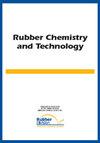IMPROVED ADHESION IN ELASTOMERIC LAMINATES USING ELASTOMER BLENDS
IF 1.5
4区 工程技术
Q4 POLYMER SCIENCE
引用次数: 1
Abstract
Interlayer adhesion between distinct rubber compositions in elastomeric laminates has been pursued by a variety of approaches, including treating surfaces, introducing assistant chemicals, and interposing a “transition layer.” Each approach, however, may be specific to the elastomer chemistries and may not be easily transferred to other rubber composition pairs in laminates. These limitations were overcome by inserting a layer at the interface that is a blend of each of the elastomer compositions of the adjacent layers and that increases the interfacial adhesion strength of the resultant laminates. This approach was demonstrated using three elastomer systems: fluoroelastomer (FKM), acrylonitrile–butadiene rubber (NBR), and isobutylene–isoprene rubber (IIR). The adhesion in the three-layer laminate (FKM/NBR/IIR) was improved with the addition of an FKM-NBR blend layer between the FKM and NBR layers and the addition of an NBR-IIR blend layer between the NBR and IIR layers. The five-layer laminate (FKM/[FKM-NBR blend]/NBR/[NBR-IIR blend]/IIR) was also fabricated. Interfacial adhesion was evaluated using the T-peel test according to ASTM D1876, which showed that the blends provided improved adhesion. Scanning electron microscope images were used to study the interface region. The proposed idea offers a general approach to improve interfacial strength that is widely applicable to other multilayer elastomer laminates.使用弹性体混合物改善弹性体层压板的附着力
弹性体层压板中不同橡胶成分之间的层间粘合已通过多种方法实现,包括处理表面、引入辅助化学品和插入“过渡层”。然而,每种方法都可能针对弹性体化学成分,并且可能不容易转移到层压板中的其他橡胶成分对。通过在界面处插入一层来克服这些限制,该层是相邻层的每种弹性体组合物的混合物,并增加所得层压板的界面粘合强度。该方法使用三种弹性体系统进行了演示:氟弹性体(FKM)、丙烯腈-丁二烯橡胶(NBR)和异丁烯-异戊二烯橡胶(IIR)。通过在FKM和NBR层之间添加FKM-NBR共混层以及在NBR和IIR层之间增加NBR-IIR共混层,改进了三层层压材料(FKM/NBR/IIR)中的粘附性。还制备了五层层压材料(FKM/[FKM-NBR共混物]/NBR/[NBR-IIR共混物]/IIR)。根据ASTM D1876,使用T型剥离试验来评估界面粘附性,这表明共混物提供了改进的粘附性。扫描电子显微镜图像用于研究界面区域。所提出的想法提供了一种提高界面强度的通用方法,该方法广泛适用于其他多层弹性体层压板。
本文章由计算机程序翻译,如有差异,请以英文原文为准。
求助全文
约1分钟内获得全文
求助全文
来源期刊

Rubber Chemistry and Technology
工程技术-高分子科学
CiteScore
3.50
自引率
20.00%
发文量
21
审稿时长
3.6 months
期刊介绍:
The scope of RC&T covers:
-Chemistry and Properties-
Mechanics-
Materials Science-
Nanocomposites-
Biotechnology-
Rubber Recycling-
Green Technology-
Characterization and Simulation.
Published continuously since 1928, the journal provides the deepest archive of published research in the field. Rubber Chemistry & Technology is read by scientists and engineers in academia, industry and government.
 求助内容:
求助内容: 应助结果提醒方式:
应助结果提醒方式:


